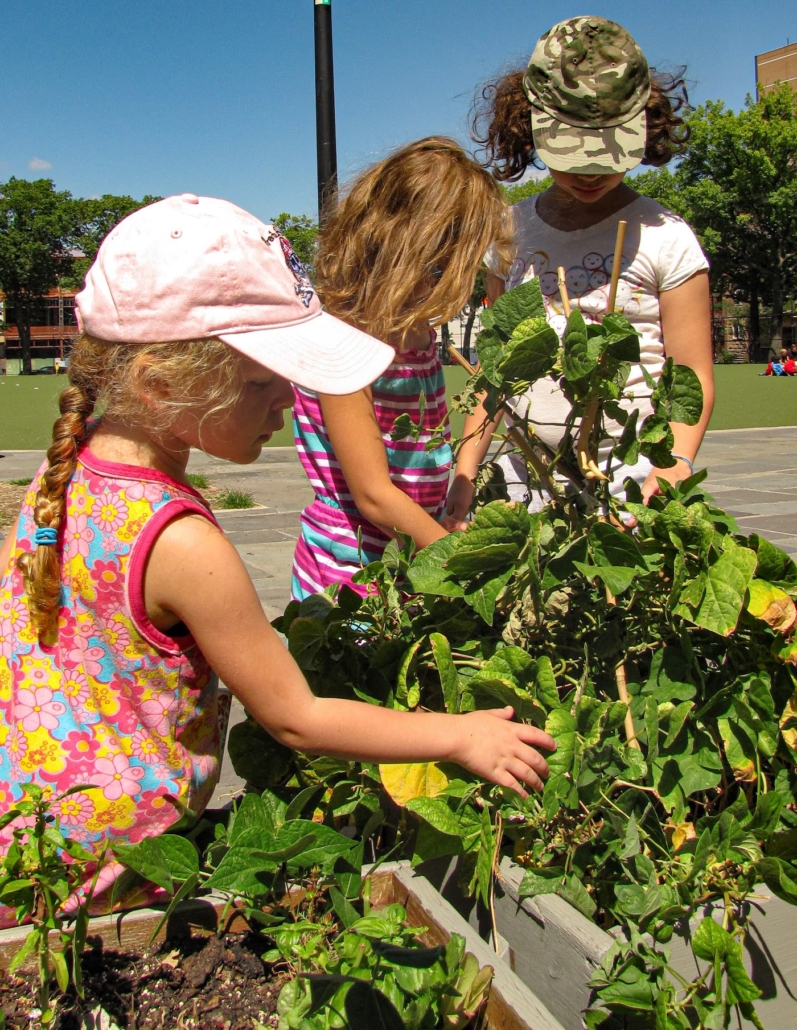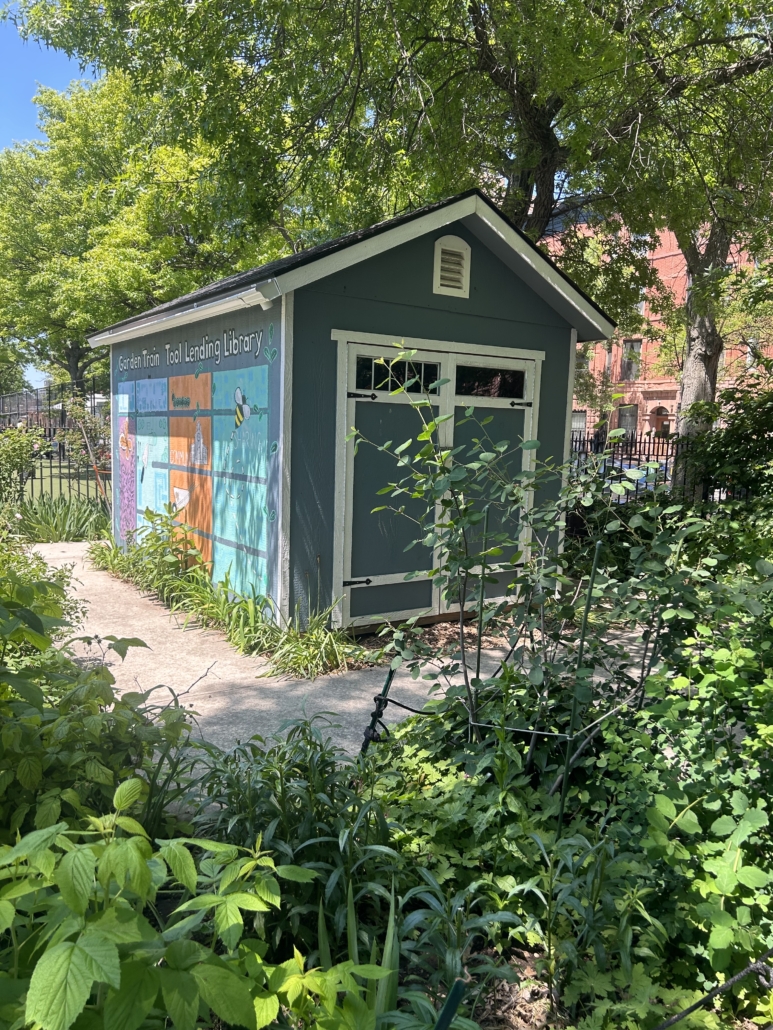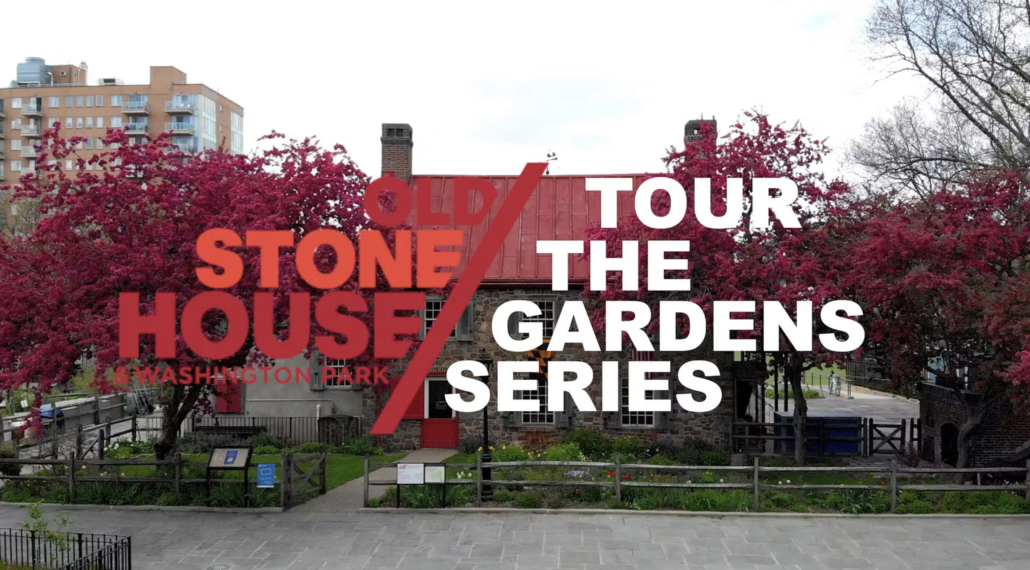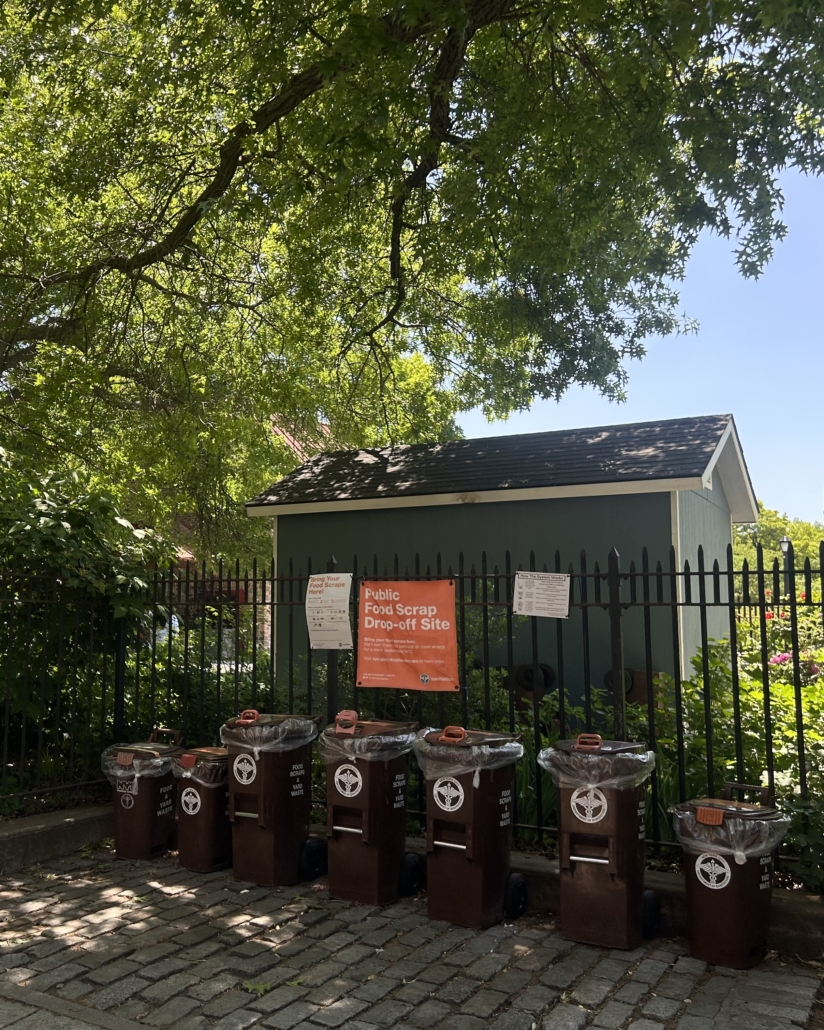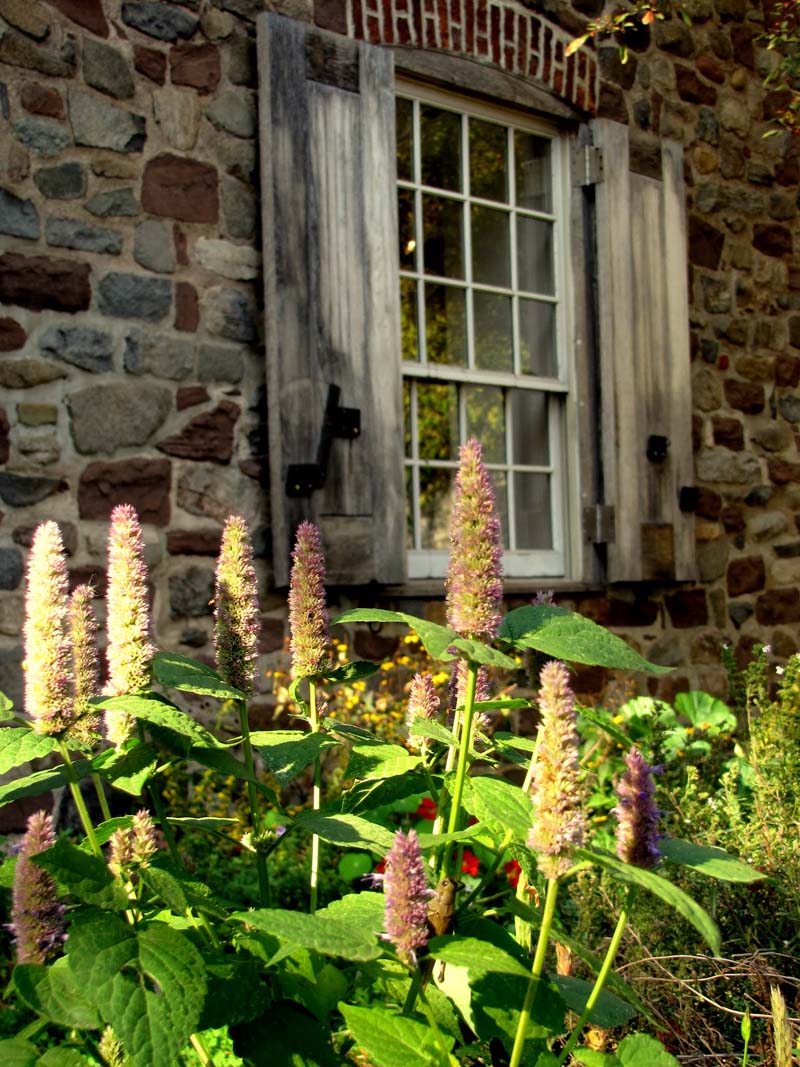Gardens
The Old Stone House gardens are open for visits from dawn to dusk. If you have questions or would like to volunteer, please reach out to Sam Lewis (he/him), OSH’s Director of Gardens at slewis@theoldstonehouse.org.
Developed under the direction of environmental educator Claudia Joseph beginning in 2004, the gardens are co-designed with our community. Volunteers and students do most of the installation, hardscaping and care-taking, in exchange for learning, health benefits, harvest and community connection.
Garden Train – Tool Lending Library
The gardens have evolved along with the gardens at our neighboring District 15 Schools. Through our partnership with Garden Train, we have established a Tool Lending Library at Washington Park. District 15 School Gardeners can call upon the resources of the Library and borrow tools for school based projects. See the tool inventory here.
Garden Tour Video Series
Our gardens are social interaction centers, as much as they are food, medicine and craft resources or stormwater retention tools, and they have brought birds and butterflies back to the landscape. Learn more from our wonderful garden video series, created with the generous support of John Freeman of Century Tree Productions – segments are approximately six to eight minutes long, and provide a wonderful overview of each of our garden spaces and the plants that define each area. Our neighbor, educator Jimmy Ferraiolo, has also worked with us on a a series about OSH’s native food forest, starting with Gooseberries!
Compost Drop Off
Since December 2021, OSH has been working with DSNY to provide a public drop-off site for community compost scraps. The compost bins are located on 3rd St just West of the house between 5th and 4th Avenues. They are next to the 3rd st entrance to the soccer fields.
We accept drop offs 24/7. You may drop off the usual compost scraps plus grains, meat, fish, dairy, and BPI certified compostable items. No plastics please. Unfortunately as we cannot accept the volume from local businesses at this time, please limit the amount to individual household drop-offs.
Any questions can be directed to Compost and Garden Coordinator Angela Lombardo (they/them) at alombardo@theoldstonehouse.org. Thank you for working with us to reduce methane output from our city! Read Angela’s 2021 OSH Compost Report.
Check out our plants!
Cover Crops
Barley
Buckwheat
Dutch white clover
Oats
Craft Plants
Basket willow
Cotton
Eastern white cedar
Flax
Job’s tears
Dye Plants
Listed by Plant
Amaranth – pinks
Comfrey – light to deep greens
Dyer’s coreopsis
Daffodils – yellow-green
Dandelion – yellow & green
Elderberry – purple, dark blue & gray
Fennel- yellow & green
Goldenrod – bright yellows to golds & greens
Japanese maple leaves – a pink blush
Mint – green
Mustard blossoms – yellow
Nasturtium – bright green
Onion skin – yellow
Polk weed
Red cabbage – from lavender to brilliant blue
Sour grass (wood sorrel or oxalis) – summery yellow
Sorrel – pale yellows & greens; roots – reddish-browns
Listed by Color:
Yellow – calendula, chamomile, goldenrod, marigold, tansy, catnip
Greens – artichoke, black-eyed Susan, hyssop, plantain
Pinks – amaranth flowers, sorrel root
Reds – dandelion root, japanese maple
Blues & purples – cornflower, false indigo, grape skins
Browns – comfrey
Grays & blacks – iris
Food Crops, Annual
Barley
Beans
Beets
Broccoli
Cabbage
Carrots
Chard
Collards
Corn
Cucumber
Eggplant
Ground cherry
Kale
Kolrabi
Komatsuna
Lettuce
Melon
Millet
Mizuna
Oats
Peppers
Potato
Radishes
Squash
Tomatillo
Tomato
Food Crops, Perennial
American plum
Beach plum
Currant
Elderberry
Gooseberry
Grape
Hazlebert
Jerusalem artichoke
Juneberry
Nanking cherry
Pear
Raspberry
Rhubarb
Western sand cherry
Native Plants
Aesculus parviflora – bottle brush buckeye
Aesclepias incarnata
Amelanchier alnifolia* – juneberry
Amelanchier canadensis
Aquilegia canadensis
Aronia brilliantissima
Aronia melanocarpa – chokeberry
Aster ericoides (Symphyotrichum)
Aster laevis (Symphyotrichum)
Aster novae-angliae (Symphyotrichum) Baptisia australis
Aster Smooth Aster
Baccharis halimifolia
Baptisia
Bayberry
Beach Plum
Black cohosh
Black-eyed Susan
Blue lobelia, Blue cardinal flower Beebalm
Blue-flag Iris
Bottlebrush Buckeye
Brown-eyed Susan Blue-stemmed Goldenrod Grassleaf Goldenrod
Bugbane
Cercis canadensis*
Christmas Fern
Cimicifuga racemosa (Actea racemosa) Eapatorium coelestinium
Clematis virginiana
Columbine Many-flowered
Coralberry
Cornus florida
Cornus sericea
Eastern White Cedar
Elderberry
Eupatorium fistulosum/maculatum/purpureum Geranium maculatum
Flowering Dogwood
Foamflower
Fothergilla minor*
Gray Goldenrod
Groundsel Bush
Hammamelis virginiana
Hardy Ageratum
Helenium autumnale
Helianthus divaricatus
Helianthus tuberosus
Highbush Cranberry
Hydrangea quercifolia
Ilex glabra
Ilex verticillata
Ilex verticillata ‘Red Sprite’
Inkberry
Iris versicolor
Jerusalem artichoke
Joe Pye Weed
Lobelia syphilitica
Lowbush Blueberry
Meadowsweet
Mist Flower,
Monarda fistulosa
Myrica pensylvanica
Netted chain fern
New York Aster
Oakleaf Hydrangea
Phytolacca americana
Pin Oak
Pinus sylvestris
Pokeweed
Polygonatum biflorum
Polystichum acrostichoides
Prunus besseyi*
Prunus maritima
Quercus palustrus
Red Chokeberry
Redbud
Rhus aromatica ‘Gro-low’
Rubus odoratus
Rudbeckia hirta
Rudbeckia triloba
Sambucus canadensis ‘Johns’ & ‘York’ Spiraea latifolia
Sneezeweed
Snowberry
Solidago caesia
Solidago graminifolia (Euthamia )
Solidago nemoralis
Solomon Seal
Swamp milkweed
Symphoricarpos orbiculatus Symphoricarpos alba
Tall Meadow Rue
Thalictrum pubescens
Thimbleberry
Thuja occidentalis*
Tiarella cordifolia
Vaccinium angustifolia
Viburnum opulus
Viola canadensis
Violet
Virgin’s Bower
Western Juneberry, Pacific Serviceberry Juneberry, Shadbush, Serviceberry Black Chokeberry
Western Sand Cherry
White Pine
Winterberry
Witch Alder
Witch Hazel
Woodland Sunflower
Woodwardia areolata
Yellow-twig Dogwood
Compiled by Cindy Goulder, November 2012
Seeds, Berries & Vegetative Cover for Birds
Currant
Gooseberry
Inkberry Ilex glabra – Songbirds: thrushes, mockingbirds, catbirds, robins, bluebirds and thrashers
Raspberry
Blackberry, Rubus allegheniensis – Blackberries rank at the top of summer foods for wildlife. Even late into the fall and winter, the dried berries are eaten by many species.
Pin Oak Acorns are a good and abundant staple food source for many songbirds.
Thimbleberry
Beach Plum
High Bush Cranberry Viburnum trilobum – Berries Sep-Feb still edible off the bush in mid-winter; popular with dozens of bird species, especially waxwings.
Elderberry Sambucus Canadensis – Elderberries are especially important sources of summer food for catbirds, robins, thrushes, sparrows, and many other songbirds.
Flowering dogwood – fruits are important to many songbirds in late summer and fall. Some primary users are cardinals, thrushes, and cedar wax-wings.
Rose – Rose hips, which remain on the shrubs through the winter and into the following year, are an important wildlife winter food source.
Winterberry, Ilex verticillata – Songbirds: thrushes, mockingbirds, catbirds, robins, bluebirds and thrashers.
Snowberry or Waxberry Symphoricarpos – Good wildlife cover and forage.
Eastern White Cedar, Thuja occidentalis Arborvitae screen.
Red Cedar fruits are eaten by cedar wax-wings, purple finches, robins, bluebirds, tree swallows, myrtle warblers and other songbirds.
Black Chokeberry Aronia melanocarcarpa – Black fruit from Sep – Nov is eaten by songbirds.
Red Chokeberry Aronia arbutifolia – Red fruits which appear Sep – Dec are an occasional winter food source for many bird species.
Juneberry or Western Serviceberry or Saskatoon Shadbush, Amelanchier ainifolia – Popular with wildlife.
Photos: Bob Levine and Madeline Wall.
Plant information: Claudia Joseph, New York Permaculture Exchange.

